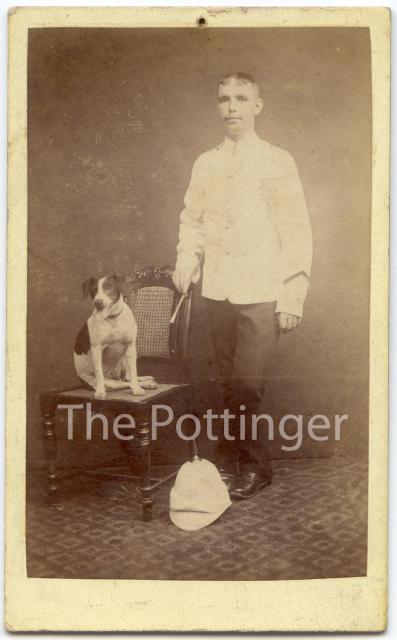Subject: [Update: Not a lance coporal at all. The strip signifies good conduct - see comments below.]
Lance corporal. I believe he's a lance corporal from the single stripe on his sleeve, but please correct me if I'm wrong. I can't sport any other identifying items to help work out who he was.
Photographer: Wing Chong
Format: carte de visite
Date: c.1885. The back of the card gives the photographer's address as "No. 74, Queen's Road, Upstairs. Opposite the Central Market." Wing Chong was there in 1885 (see https://gwulo.com/node/31857)
Photo courtesy of The Pottinger Hong Kong hotel.
Date picture taken
1885
Gallery

Comments
Military uniforms and ranks - 19th century
Despite having served for 27 years in the Territorial Army, the insignia leaves me scratching my head! The only time I remember seeing inverted chevrons was on the cuff of the Drum Major, but he had four.
The National Army Museum (www.nam.ac.uk) is likely to be a better source of information than me! They have a "contact us" page at https://www.nam.ac.uk/contact-nam
re: Military uniforms and ranks - 19th century
Thanks Paul, I've since learned I was way off with my "lance corporal" guess!
Ron, James and Martin emailed me to explain that stripes showing soldiers' rank all point down. A soldier could also receive stripes pointing up for good conduct - with additional stripes as the years passed. Here's James Fell's explanation:
It's a good conduct stripe for good conduct during service in the Regular Army by an enlisted man. The insignia was a points-up chevron of NCO's lace worn on the lower sleeve of the uniform jacket. It was given to Privates and Lance Corporals for 2, 6, 12, or 18 years' service without being subject to formal discipline. A further stripe was awarded for every 5 years of good service after the 18th (23-, 28-, 33-, 38-, 43-, or 48 years). If the soldier had never had their name written in the Regimental Conduct Book, they earned the 4th, 5th, 6th, and 7th stripes after 16-, 21-, 26-, and 32 years respectively.
So we're looking at a Private who'd had between 2-5 years of good conduct.
No badge
I wondered if the fact there isn't any badge visible on his hat meant anything. This article about pith helmets says it was common to have no badge, so it doesn't tell us anything more about this man:
One major misconception of the Foreign Service Helmet is that these all had the unit plates on the front. No doubt, this is due to movies such as “Zulu,” starring Michael Caine and Stanley Baker. But in fact, most of the Foreign Service Helmets never were fitted with helmet plates or any form of badges while being used by the British Army, and almost certainly not on campaign.